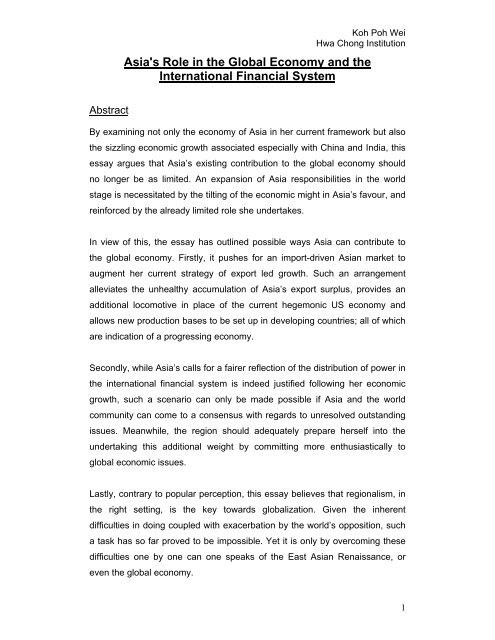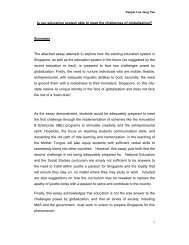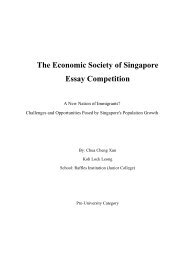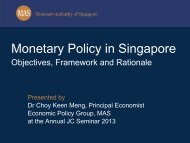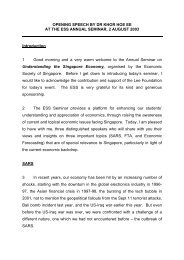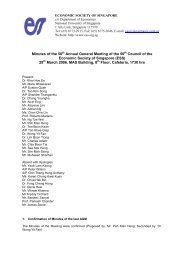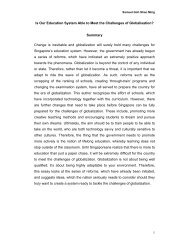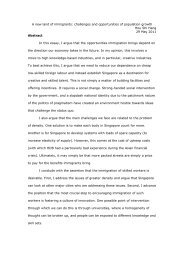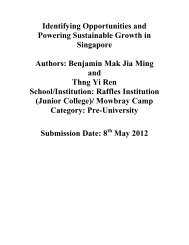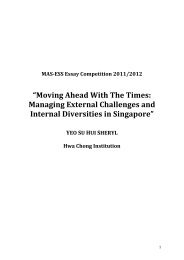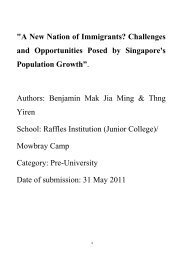Mr Koh Poh Wei - Economic Society of Singapore
Mr Koh Poh Wei - Economic Society of Singapore
Mr Koh Poh Wei - Economic Society of Singapore
Create successful ePaper yourself
Turn your PDF publications into a flip-book with our unique Google optimized e-Paper software.
<strong>Koh</strong> <strong>Poh</strong> <strong>Wei</strong><br />
Hwa Chong Institution<br />
Asia's Role in the Global Economy and the<br />
International Financial System<br />
Abstract<br />
By examining not only the economy <strong>of</strong> Asia in her current framework but also<br />
the sizzling economic growth associated especially with China and India, this<br />
essay argues that Asia’s existing contribution to the global economy should<br />
no longer be as limited. An expansion <strong>of</strong> Asia responsibilities in the world<br />
stage is necessitated by the tilting <strong>of</strong> the economic might in Asia’s favour, and<br />
reinforced by the already limited role she undertakes.<br />
In view <strong>of</strong> this, the essay has outlined possible ways Asia can contribute to<br />
the global economy. Firstly, it pushes for an import-driven Asian market to<br />
augment her current strategy <strong>of</strong> export led growth. Such an arrangement<br />
alleviates the unhealthy accumulation <strong>of</strong> Asia’s export surplus, provides an<br />
additional locomotive in place <strong>of</strong> the current hegemonic US economy and<br />
allows new production bases to be set up in developing countries; all <strong>of</strong> which<br />
are indication <strong>of</strong> a progressing economy.<br />
Secondly, while Asia’s calls for a fairer reflection <strong>of</strong> the distribution <strong>of</strong> power in<br />
the international financial system is indeed justified following her economic<br />
growth, such a scenario can only be made possible if Asia and the world<br />
community can come to a consensus with regards to unresolved outstanding<br />
issues. Meanwhile, the region should adequately prepare herself into the<br />
undertaking this additional weight by committing more enthusiastically to<br />
global economic issues.<br />
Lastly, contrary to popular perception, this essay believes that regionalism, in<br />
the right setting, is the key towards globalization. Given the inherent<br />
difficulties in doing coupled with exacerbation by the world’s opposition, such<br />
a task has so far proved to be impossible. Yet it is only by overcoming these<br />
difficulties one by one can one speaks <strong>of</strong> the East Asian Renaissance, or<br />
even the global economy.<br />
1
1. Introduction<br />
<strong>Koh</strong> <strong>Poh</strong> <strong>Wei</strong><br />
Hwa Chong Institution<br />
An economy is the management <strong>of</strong> resources and the distribution <strong>of</strong> wealth<br />
within a system. Given that a predefined system is the prerequisite to the<br />
workings <strong>of</strong> an economy, the term “global economy” entails the amalgamation<br />
<strong>of</strong> world economies and requires a holistic perspective to otherwise separate<br />
entities. Since collectivity is pertinent to a global economy, it is usually<br />
characterized by the liberalization <strong>of</strong> the flow <strong>of</strong> goods and services, the<br />
eroding <strong>of</strong> state boundaries and the weakening <strong>of</strong> the powers associated with<br />
the state. In the global economy, the international financial system plays a<br />
role equivalent to states in their domestic economies; a governing body<br />
enforcing financial regulations and overseeing international transfers.<br />
Why then, does one see the need to participate in the global economy How<br />
does one contribute to the global economy Most importantly, should one<br />
position himself with the global economy to such an extent that his interest is<br />
compromised This paper shall answer these questions from the angle <strong>of</strong> a<br />
dynamic economic region – Asia.<br />
2. An Analysis into <strong>Economic</strong> Development in Asia<br />
The ascent <strong>of</strong> Asia’s economy in the last quarter <strong>of</strong> a century is highly<br />
remarkable. From Asian Tigers 1 and ASEAN to Japan, the world has seen<br />
economies recording unprecedented, nearing double digit growth rates over<br />
the years (Fig 2). However, these economies, impressive their developments<br />
were, can only be viewed in lesser light when comparing with global<br />
heavyweights. While Japan undeniably remains as the region’s powerhouse<br />
geographically, not many will view her so when defining the Asia in political<br />
and economical context due to her alignment with Western economies (Vogel,<br />
2002, 2004a: 1). Moreover, having peaked by the 1990s, Japan has<br />
established herself as a global leader who contributes massively to the world<br />
1 “Asian Tiger” refers to the Newly Industrialized Countries- <strong>Singapore</strong>, South Korea, Hong Kong and<br />
Taiwan. By 1990, these countries, with 1.4% <strong>of</strong> the world population, accounted for 8.6% <strong>of</strong> the global<br />
market (1992a:1)<br />
2
<strong>Koh</strong> <strong>Poh</strong> <strong>Wei</strong><br />
Hwa Chong Institution<br />
finance system. 2 That Asia is in the limelight in the 21 st century is as a result<br />
<strong>of</strong> the thrust provided by China and India, and for this reason, while still taking<br />
other Asian economies into due consideration, this paper shall study the two<br />
economies in greater depth.<br />
Approximately two decades after the drastic pro-market reforms 3 swept their<br />
economies; China and India were no longer that <strong>of</strong> the yesteryear. The<br />
massive influx <strong>of</strong> Foreign Direct Investments (FDI) 4 and production <strong>of</strong> exports<br />
propels these economies forward at such breakneck speed that even<br />
conservatives keen to make their point on trade restrictions will attribute, to a<br />
certain degree, China and India’s economic growth to their participation in the<br />
global economy. Today, China and India are the fourth and tenth largest<br />
economy in the world, and is still growing.<br />
The potential <strong>of</strong> Asia is never disputed. Populous Asia is <strong>of</strong>ten linked with the<br />
economics <strong>of</strong> scale she enjoys and comparative advantage as a low wage<br />
labour market. Demographically, Asians are in their prime years and investors<br />
are hence more likely to view them as being consumption-orientated.<br />
Geographically, the mobility <strong>of</strong> factors <strong>of</strong> production and the proximity <strong>of</strong> Asian<br />
cities those factors encourages the agglomeration <strong>of</strong> production (Ottaviano,<br />
1997).<br />
3. World Trade<br />
Asia’s integration into the world trading system has been a win-win situation<br />
for both Asian and the global economy, By blending large quantity <strong>of</strong> capital,<br />
which originated from massive FDI and entrepreneurs, with low wage market,<br />
Asia’s economy is able to generate an upward spiral in production (Fig. 1)<br />
2 Japan is a leader in many international finance institutions, most significantly being a co-founder <strong>of</strong><br />
the Group <strong>of</strong> Seven (G7). It has consistently ranked top in the Official Donor Assistance (ODA)<br />
scheme.<br />
3 China’s program <strong>of</strong> economic changes, “Socialism with Chinese characteristics” was led by Deng<br />
Xiaoping and started in 1978. The economic liberalization <strong>of</strong> India in 1991 initiated by Narasimha Rao<br />
did away with License Raj and granted automatic FDI approval in many sectors.<br />
4 China attracts US$40 billion <strong>of</strong> FDI and is the world greatest exporter in 2003. While India lags far<br />
behind, it is opening up to FDI as well.<br />
3
<strong>Koh</strong> <strong>Poh</strong> <strong>Wei</strong><br />
Hwa Chong Institution<br />
which caters to international (as opposed to domestic) demand. This exportled<br />
strategy 5 has so far been able to propel Asia’s economy to high growth,<br />
and allowed international economies, especially developing ones, to enjoy<br />
cheaper prices for economic goods.<br />
Although such a strategy has so far proved to be effective, global economist<br />
should still be concerned given the far reaching repercussion <strong>of</strong> an overreliance<br />
on international imported demand. In the last 30 years, US<br />
constitutes a vast majority <strong>of</strong> the international net exported demand (Fig. 3),<br />
implying a worrying yet unnecessary dependence on trade on the United<br />
States, given the might <strong>of</strong> Asia she should be able to stand on her own.<br />
The solution to the pessimism surrounding the dominance <strong>of</strong> US lies in an<br />
expansion <strong>of</strong> Asia’s role in the global economy. Traditionally, much <strong>of</strong> Asia’s<br />
resources have been directed towards creating means <strong>of</strong> production to satisfy<br />
world demand. However, as the growth <strong>of</strong> Asia’s economy outpaces the<br />
growth in international demand, producers should now cater for domestic<br />
consumption instead. From the viewpoint <strong>of</strong> the global economy, Asia has<br />
outgrown her role a production base and it is now timely for her to play the<br />
global consumer instead.<br />
But why Asia, one may ask Firstly, producers should note that Asia accounts<br />
for over half the world population and is henceforth a massive untapped<br />
market. With Asia’s economic growth, the spending power <strong>of</strong> consumers rises,<br />
and so should production catering to domestic demand. Producers should<br />
also realize that marginal consumption decreases with increased consumption,<br />
making it more viable to direct more resources to locals’ consumption, rather<br />
than investment and eventually to developed world citizens whose appetites<br />
are largely satisfied. Secondly, viewing from national interest, many Asian<br />
countries, especially China, have accumulated large reserves and US<br />
securities from trading surpluses over the years. The value <strong>of</strong> these securities<br />
is based entirely on confidence towards the US economy and with<br />
5 In 1995-2000, the export to GDP ratio is 41.4%, an indicator <strong>of</strong> Asia’s reliance on trade strategy<br />
4
<strong>Koh</strong> <strong>Poh</strong> <strong>Wei</strong><br />
Hwa Chong Institution<br />
accumulation, is low-yielding. It hence serves better to utilize these securities<br />
now then in the future. Thirdly, the government needs to take into account the<br />
casual relation between economic growth and economic welfare. For Asia,<br />
rising opportunity costs <strong>of</strong> economic growth has been brought about by<br />
overinvestment, the consequence being the lack <strong>of</strong> production <strong>of</strong> consumption<br />
goods, which is a better measure <strong>of</strong> economic welfare. To the global economy,<br />
Asia’s shift to that <strong>of</strong> a global consumer not allow provides an alternative to<br />
US preponderance but also allow developing countries to set up their own<br />
production bases.<br />
Fortunately, having recognized the importance <strong>of</strong> domestic consumption, both<br />
the China and India government have already introduced fiscal policies to<br />
stimulate them. 6 Critics, however, may link expansionary policies with the<br />
controversial Keynesian economics. Contrary to these associations, one<br />
should instead view the role <strong>of</strong> the government to that <strong>of</strong> correcting market<br />
inefficiencies and safeguarding interests <strong>of</strong> citizens, whereby increased<br />
consumption is as a result. For instance, demand for economic goods will rise<br />
by cracking down on pirated goods which act as substitutes. Poverty<br />
reduction might increase the rate <strong>of</strong> increase <strong>of</strong> marginal propensity to<br />
consume, henceforth increasing production.<br />
Supply constitutes its own demand, so says classical economist Jean-<br />
Baptiste Say. Ultimately, the onus lies in Asian producers to create supply so<br />
that demand will increase. For Asia, this demand is crucial in maintaining its<br />
growth momentum. In the global economy, Asia’s role lies in rebalancing the<br />
distribution <strong>of</strong> world trade.<br />
4. International Financial System and Global Issues<br />
6 Both China and India have attempted to stimulate demand by introducing policies that encouraged the<br />
setting up more financial institutions with higher monetary loan and lower interest rate since 2004.<br />
5
<strong>Koh</strong> <strong>Poh</strong> <strong>Wei</strong><br />
Hwa Chong Institution<br />
Following the rise <strong>of</strong> sophisticated Asian economies such as Japan 7 , and<br />
more recently, China and India, and the near saturation <strong>of</strong> the United States<br />
economy, there is a distinct distribution <strong>of</strong> economic power. Bolder<br />
economists are already questioning US status as a financial hegamon in the<br />
near future. Having established the might <strong>of</strong> Asia economy earlier in this<br />
paper, I believe that it will be inevitable that international financial institutions<br />
confer a greater role to Asia reflecting on its economic power. However, to<br />
gain approval in the international community, the Asian economy, especially<br />
China, must show a greater commitment to global issues.<br />
Japan, China and India, with the second, fourth and tenth largest economies<br />
in the world, are clearly Asian countries which have reached a point whereby<br />
they can influence the global economy. Yet these countries, in particular<br />
China and India, hold little influence in affecting or changing financial<br />
regulations, partly because their interactions with the global economy only<br />
started during the 1990s. India, wanting to achieve self reliance, closed her<br />
door to the international finance system until recently. Similarly, China began<br />
participating in international economic groupings only recently, having joined<br />
the International Monetary Fund (IMF) in 1980 and World Trade Organization<br />
(WTO) in 2001. While Asia has maintained a good track record <strong>of</strong> cooperating<br />
with these organizations, establishing her position in these organizations<br />
takes time.<br />
Political insecurities may also account for the reluctance <strong>of</strong> the international<br />
community to accept Asia’s place in the international financial system. The<br />
collapse <strong>of</strong> the Soviet Union might have taken place long ago, but the policy<br />
<strong>of</strong> containment still remained deeply rooted in Western democracies,<br />
explaining for the lukewarm reactions to the rise <strong>of</strong> countries affiliated with<br />
communism, examples being Vietnam, China and Myanmar. For example, the<br />
tying up <strong>of</strong> trade with human rights resulted in widespread resentment in<br />
7 Gilpin argued in the late 1980s that Japan was already the financial hegemony in Asia. Strange (1990)<br />
claimed that while US holds power to shape financial structure to its end, Japan now wields a certain<br />
amount <strong>of</strong> power<br />
6
<strong>Koh</strong> <strong>Poh</strong> <strong>Wei</strong><br />
Hwa Chong Institution<br />
China, in what was perceived to be a hidden political agenda to impose<br />
Western values on non-Western countries (Moore, 2000).<br />
To rectify such problems, Asia must continue to prove herself in the world<br />
stage. China’s participation in organizations such as the G-20 is no doubt<br />
laudable (Yu, 2005), but Asia cannot afford to limit herself to mere<br />
participation, but should advocate issues to the benefit <strong>of</strong> the international<br />
community, and respond to their concerns.<br />
One issue which concerns the world community will be the impact <strong>of</strong><br />
economic growth in Asia to the environment. While critics <strong>of</strong> indicators <strong>of</strong><br />
uneconomic growth maintain that environmental well-being should be left to<br />
individual’s pursuit, the negative externalities <strong>of</strong> ecological damage and<br />
pollution are heavy. On the other hand, the world community could not expect<br />
Asia, a developing economy, to adhere to the 3% growth rate that ecologies<br />
could sustain without damage (Suzuki, 1998). Whereas concessions are<br />
usually given to developing economies, the magnitude <strong>of</strong> Asia both in<br />
economic growth and size amplifies this negative externality and might cause<br />
discontentment amongst the world community. In fact, it is worthwhile to note<br />
that more than three-quarter <strong>of</strong> the world’s ten most polluted cities are from<br />
Asia. In this aspect, Asia should proactively seek to reach a consensus with<br />
the world community.<br />
The abidance by international trade laws has been another controversial issue<br />
<strong>of</strong> Asia surrounding the global economy. The fact that Asia, especially China,<br />
have large economies running on massive trade surpluses place her as a<br />
world competitor, and hence exacerbates the reaction <strong>of</strong> her flouting<br />
international laws. Asia’s failure to crack down on intellectual property rights<br />
(IPR) violations has, for instance, been a source <strong>of</strong> tension between herself<br />
and the world community. China’s alleged manipulation <strong>of</strong> the yuan has been<br />
another. Yet critics should be reminded that, with the development <strong>of</strong> Asian<br />
economies, it is <strong>of</strong> Asia’s best interest to set up intellectual property laws.<br />
Instead <strong>of</strong> pushing for an immediate adoption <strong>of</strong> a free market exchange rate,<br />
the world community should also respect China’s need to contain ill effects <strong>of</strong><br />
7
<strong>Koh</strong> <strong>Poh</strong> <strong>Wei</strong><br />
Hwa Chong Institution<br />
massive speculation and instead encourage first a partial floating system, the<br />
direction she is heading towards.<br />
Already, the IMF has echoed Asia’s concern with regards to her lack <strong>of</strong> clout<br />
in the financial system relative to its economic power and urges the<br />
international community to look into this matter in order to fulfill IMF’s mandate<br />
<strong>of</strong> a greater global economic stability (2005:a). Meanwhile, Asia should<br />
adequately prepare herself to undertake the responsibility attached to greater<br />
power.<br />
5. Regionalism and Globalization<br />
That the term ‘regionalism’ is linked with ‘globalization’ in the first place might<br />
be puzzling to many. How does regionalism advances globalization when it<br />
reinforces the very geographical boundaries that globalization seeks to<br />
eliminate In what way does the apparent definition <strong>of</strong> Asia not conflict with its<br />
integration Consequently, the world community, unsettled by these rhetorical<br />
questions, is diametrically opposed to any attempts by Asian countries to<br />
regionalize 8 . Yet in doing so the world community is instead destroying the<br />
link between Asia and the world.<br />
The world’s reaction, albeit inappropriate, can be easily understood. The<br />
concept <strong>of</strong> regionalism has long been associated with negative protectionism,<br />
where countries in the region form trading blocs, accorded preferential<br />
treatment only to one another and closed their doors to the global economy.<br />
Surely it is in the world’s interest to prevent this outcome at all cost<br />
The lack <strong>of</strong> regionalism might worsen the anti-globalization stance already<br />
adopted by certain Asian countries. It is precisely regionalization, or the lack<br />
<strong>of</strong> it, that saw China and India not opening their doors to foreign trade in the<br />
earlier decade. In contrast, <strong>Singapore</strong>, having reaped the benefits <strong>of</strong><br />
8 Japan’s proposal for an Asian Monetary Fund (AMF) to be set up is rejected unanimously by both the<br />
United States and the International Monetary Fund (IMF) twice in 1998 and 2000. Initiatives for<br />
private meetings between Asia Pacific countries have also been blocked by the United States.<br />
8
<strong>Koh</strong> <strong>Poh</strong> <strong>Wei</strong><br />
Hwa Chong Institution<br />
regionalization, later moved on to become one <strong>of</strong> the freest economies in the<br />
world. No longer is the assumption that regionalization will result in a<br />
tendency for the world to shut its door to the global economy accurate.<br />
Regionalization today should instead be viewed as a stepping stone which<br />
provides conservative states with an option to open up their economies on a<br />
smaller, regional basis. Given the risk that globalization itself carries when it<br />
forces the economic door open, for example when in the wake <strong>of</strong> the 1997<br />
Asian Financial Crisis, it is pertinent that states cooperate with one another,<br />
with regionalism being a good avenue to do so. Having recognized the<br />
inherent benefits <strong>of</strong> regionalism, states will then be encouraged to open up to<br />
a larger platform, and ultimately, the global economy.<br />
If the regionalism <strong>of</strong> Asia were to take place, however, we should see it<br />
differently from the conventional paradigm which we viewed from the<br />
regionalism <strong>of</strong> entities such as the European Union (EU). The economies <strong>of</strong><br />
Asia are intertwined naturally in the first place; without the “teamwork” in place<br />
the Asian development would never have been that impressive. Indeed, Okita<br />
(1996) likens the pattern <strong>of</strong> development in Asia to the “flying geese”, where<br />
less developed economies, having access to others’ capital and technology,<br />
bypass essential developmental steps and grow rapidly.<br />
However, the existence <strong>of</strong> such “teamwork” is yet to be recognized. In fact,<br />
there has yet to be a single organization representing Asia economically, with<br />
the membership <strong>of</strong> the Asia Pacific <strong>Economic</strong> Cooperation (APEC) being too<br />
diverse 9 to promote Asia’s interest, and former Malaysian Prime Minister<br />
Mahatir’s proposal for the East Asia <strong>Economic</strong> Grouping (EAEG) fading away<br />
in the 1990s. Failure <strong>of</strong> regionalism has been largely due to reluctance for a<br />
country to lead financially, with separate blocs in Asia pushing for their own<br />
interest. Asia itself is politically, economically and culturally diverse, and the<br />
large differences between each state are undeniable. The political rivalries<br />
and tensions between China and Japan are also significant, given that those<br />
states have the two largest Asian economies. The world’s opposition towards<br />
9 More than a third <strong>of</strong> the 21 APEC members are not from Asia<br />
9
<strong>Koh</strong> <strong>Poh</strong> <strong>Wei</strong><br />
Hwa Chong Institution<br />
any move with bearings <strong>of</strong> regionalism makes it all the more daunting. The<br />
result is an awkward and unreliable style <strong>of</strong> “teamwork”, falling short <strong>of</strong><br />
regionalism, which Asian countries cannot rely upon.<br />
Optimists, however, point out to the East Asian Renaissance, the resurgence<br />
<strong>of</strong> the mighty ancient historical civilization and great political empire that Asia<br />
once was. Leading the quest <strong>of</strong> Asia’s return to power would be China and<br />
India, the growth engines <strong>of</strong> today. Yet this empire does not foolishly close her<br />
trade routes, but instead, builds more <strong>of</strong> them. This is the new regionalism, an<br />
empire built on the basis <strong>of</strong> a multipolar world order.<br />
Indeed, the establishment <strong>of</strong> ASEAN Plus Three (APT), a dialogue between<br />
Asian countries, can already be viewed as the catalyst for this progress.<br />
ASEAN, already an established grouping, can serve to bridge the divide<br />
between Sino-Japan relations, ins<strong>of</strong>ar the limiting reagent to the growth <strong>of</strong><br />
Asia’s economy. <strong>Economic</strong> heavyweights Japan and China can work towards<br />
developing a financial mechanism, helping developing economies in the<br />
process. Moreover, the transfers <strong>of</strong> trade, investments and technologies have<br />
already been a parcel <strong>of</strong> the workings <strong>of</strong> the Asia economy and APT can<br />
serve to provide an institutional framework to it, thereby enhancing the<br />
process (Alatas, 2001).<br />
Already, significant achievements have been made by APT. The Chiang Mai<br />
Initiative provides a safety rope for Asian economies to cling to in the event <strong>of</strong><br />
a crisis. If a Free Trade Agreement, currently in negotiation, is to be set up,<br />
Asian countries will only stand to gain collectively, the percentage <strong>of</strong> welfare<br />
gain illustrated by Figure 4. But APT is neither about numbers nor selfish<br />
personal gains <strong>of</strong> Asia. APT forwards regionalism, a concept in sync with<br />
globalization.<br />
Critics, <strong>of</strong> course, will not fail to point out the shortcomings <strong>of</strong> APT and doom it<br />
to failure. But are other regional organizations, such as European Union, then<br />
completely flawless The journey <strong>of</strong> a thousand miles starts with a single step,<br />
10
<strong>Koh</strong> <strong>Poh</strong> <strong>Wei</strong><br />
Hwa Chong Institution<br />
so goes a Chinese proverb. If APT can prove to be the first step, Asia is not<br />
far away from being a pure integrand <strong>of</strong> the global economy.<br />
6. Conclusion<br />
The global economy needs Asia, as much as Asia needs the global economy.<br />
Being mutually dependant, it serves Asia to contribute to her best <strong>of</strong> the<br />
abilities so that both parties can benefit as much as possible. Given the<br />
spirited growth associated with Asia, so should her contributions. In terms <strong>of</strong><br />
trade, Asia can expand her role via a gradual shift <strong>of</strong> emphasis from<br />
production to consumption. The international financial system is also a direct<br />
platform whereby Asia can play her role as an emerging power, instead <strong>of</strong> the<br />
silent participant that she usually is. Yet in order to work with the world, Asian<br />
countries must first be able work with each other.<br />
Both Asia and the world community are concerned about the global economy,<br />
but when taking their different approaches towards their concerns, there<br />
bound to be friction among them. In the face <strong>of</strong> this, both parties should bear<br />
in mind that the improvement <strong>of</strong> the global economy is not a strictly<br />
competitive game, whereby Asia’s gain is equated with the world’s loss.<br />
Instead, such a game is strictly cooperative, and only by working hand in hand,<br />
with the presence <strong>of</strong> mutual accommodation and compromise, can the<br />
concept <strong>of</strong> the global economy be a reality.<br />
11
<strong>Koh</strong> <strong>Poh</strong> <strong>Wei</strong><br />
Hwa Chong Institution<br />
Appendices<br />
Figure 1<br />
Figure 2<br />
12
<strong>Koh</strong> <strong>Poh</strong> <strong>Wei</strong><br />
Hwa Chong Institution<br />
Figure 3<br />
Figure 4<br />
13
Bibliography<br />
<strong>Koh</strong> <strong>Poh</strong> <strong>Wei</strong><br />
Hwa Chong Institution<br />
1. Stephen Vogel ed, “US-Japan Relations in a Changing World”, Brooking<br />
Institutional Press, c. 272pp, 2002<br />
2. Embassy <strong>of</strong> Japan, “Japan-US Relations”, December 1, 2004<br />
3. Ottaviano, G. and Puga, D. ”Agglomeration in the Global Economy: A<br />
survey <strong>of</strong> the “New <strong>Economic</strong> Geography‘, Centre for <strong>Economic</strong><br />
Performance, London School <strong>of</strong> <strong>Economic</strong>s and Political Science, 1997<br />
4. Saburo Okita, “The Lessons <strong>of</strong> <strong>Economic</strong> Development in East and<br />
Southeast Asia”, Development Trade and the Asia-Pacific, Prentice Hall<br />
<strong>Singapore</strong>, c. 13: 211-214pp, 1996<br />
5. World Bank, World Development Report 1992a<br />
6. Asia Development Bank, Asian Development Outlook 1992<br />
7. Gregory J. Moore, “Human Rights and United States Policy towards China<br />
in the New Millennium”, Graduate School <strong>of</strong> International Studies,<br />
University <strong>of</strong> Denver, Jan 2000<br />
8. Yongding Yu, “G-20 and China: A Chinese Perspective”, China & World<br />
Economy / 3-14, Vol. 13, No. 1, 2005<br />
9. David Burton, “A Role <strong>of</strong> Asia for the World Economy”, Director, Asia and<br />
Pacific Department, International Monetary Fund, 2005<br />
10. Suzuki, D.T. (1998), “Earth Time”, St Leonards, Australia: Allen & Unwin<br />
11. Ali Alatas, “ASEAN Plus Three Equals Peace Plus Prosperity”, Institute <strong>of</strong><br />
South East Asian Studies 2001<br />
14


